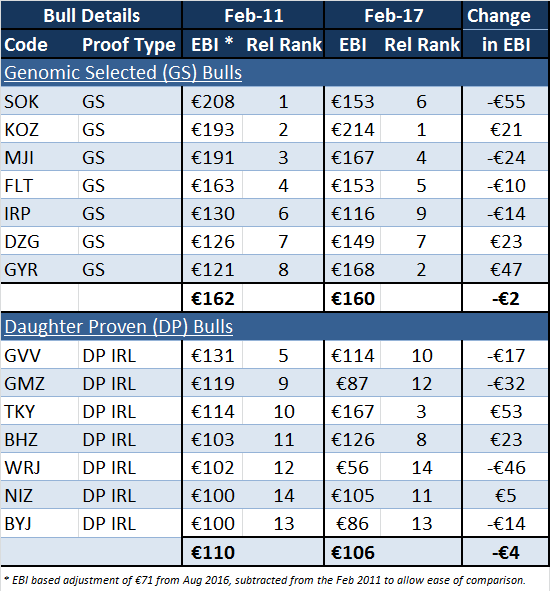The recent changes to proofs for genomic bulls has left a lot of farmers wondering whether they should continue using Genomically Selected (GS) bulls in their breeding program this Spring or whether they should revert back to the “tried and trusted” Daughter Proven bulls (DP) when making their AI bull choices?
In seeking to answer this question, ICBF and Teagasc have just completed a significant piece of work comparing the performance of 7 high EBI Genomic bulls from the 2011 ICBF Active Bull list with 7 high EBI Daughter Proven bulls from the same listing. The bulls were selected based on being the highest EBI bulls within each category at that time, and included bulls such as SOK, KOZ and FLT in the GS category and BHZ, BYJ and GMZ in the DP category.
The analysis first compared the proofs of the 14 bulls in February 2011 with their proofs from February 2017. Looking at data from Table 1 indicates that, on average, the team of 7 GS bulls were some €52 ahead of the team of 7 DP bulls in 2011, and that this difference in EBI was still there some 6 years later, despite having added almost 100,000 progeny records across the group of bulls in the intervening time period. This analysis clearly confirms the ability of genomics to accurately identify superior animals at a young age (i.e., 2 years for young GS bulls) without the need to wait until they have a daughter proven proof (when the bull is then 6 years of age).

There are another number of very relevant points to the data contained in Table 1. Firstly, EBI values for some of the GS bulls have fallen significantly during the period (e.g., SOK who dropped by €55). However, the same is also clear for the DP bulls, with a bull such as WRJ dropping by €46. Indeed there is little difference in the level of EBI changes for the GS bulls compared to the DP bulls, which reflects completely the fact that even though we term these DP bulls as Daughter Proven, this is only for the milk traits and not for the key fertility traits that make up of EBI. If we want AI bulls to be fully daughter proven for female fertility then we would need to wait another 3-4 years before using such bulls.
In terms of changes to proofs for individual bulls (which happen equally for both GS and DP bulls), the key to then managing this risk is to use a team of bulls. It is interesting to note from the data in Table 1 that the average change for both groups of bulls has remained relatively unchanged at -€2 for the GS bulls and -€4 for the DP bulls. This absolutely confirms the need for farmers to use teams of AI bulls equally across their herd, when making breeding decisions for their farms. It also confirms the need to use teams of GS bulls, as opposed to daughter proven bulls, as these are, on average, €50 ahead of the DP bulls at any given point in time.
The second aspect of the analysis undertaken by ICBF and Teagasc was to establish what difference (if any) existed between the progeny of the high EBI GS bulls compared to the high EBI DP bulls, based on performance of their progeny on commercial dairy farms. The analysis was based on 33,577 females calves born during 2012 from the 14 AI bulls identified in Table 1 above.

Looking at data from Table 2 clearly indicates that the progeny of the high EBI GS bulls had significantly better milk solids and fertility performance, compared to the progeny of the high EBI DP bulls. Indeed looking at the differences in actual performance across the first three lactations (some 3 days in calving interval, 5% in survival and 34 kg F+P), more than confirms the estimate taken from the EBI of €50/lactation. So as with the previous analysis based on EBI data (Table 1), the analysis based on actual daughter performance confirms completely the value of using genomics to help farmers more quickly identify the most superior genetics for delivering increased profitability at farm level.
So the answer to the question of whether or not to use a team of High EBI Genomic Bulls is very definitely YES.
For more detail on the tables behind this text, please click here on presentation button below.

